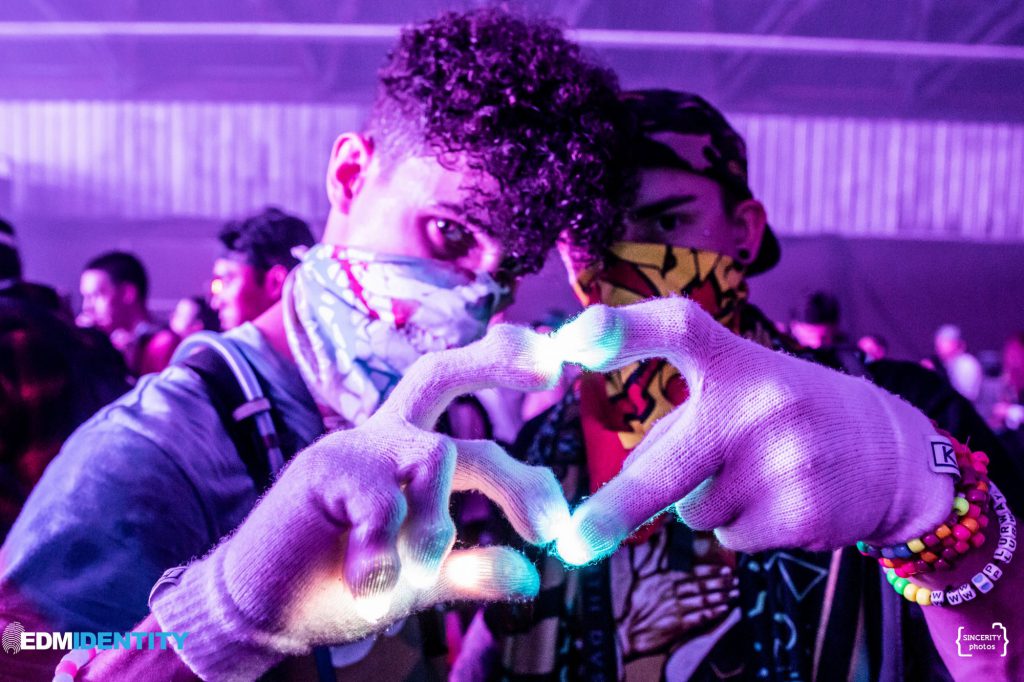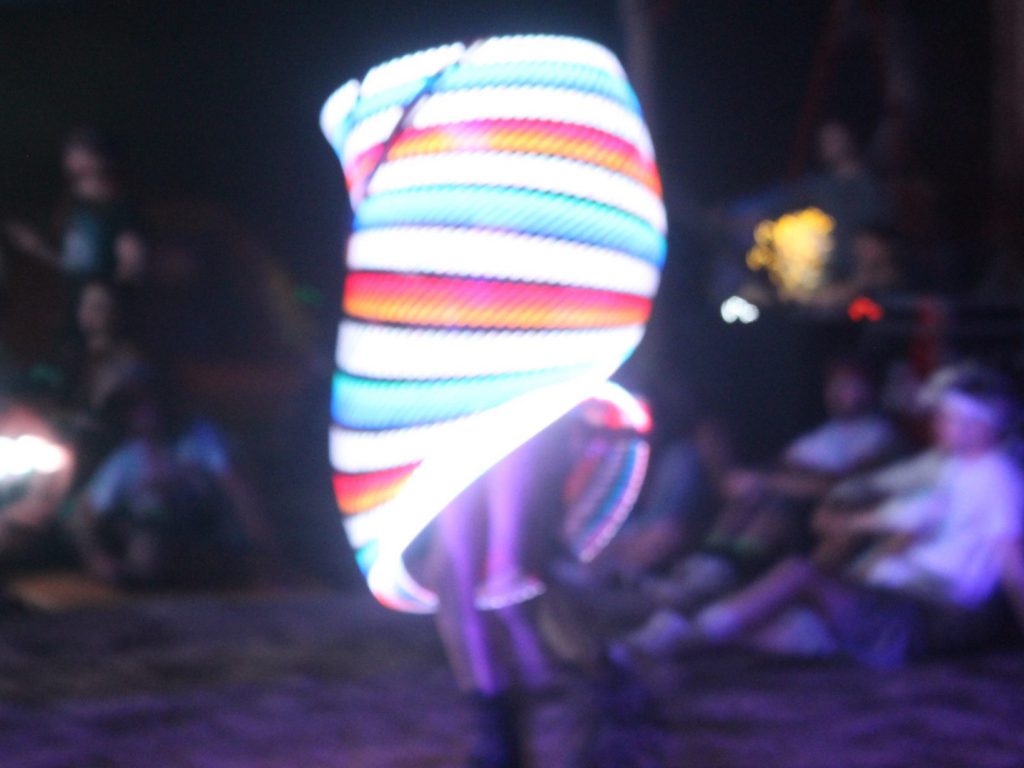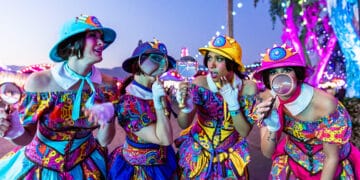Dive into the meaning behind flow arts, how it originated, and why it’s become an indispensable part of the rave and festival scene.
One of the biggest attractions at music festivals and electronic shows isn’t always what’s found on the stage; instead, it’s inside the crowd where a plethora of flow arts are being performed. While the main portion of the dancefloor might be cluttered with attendees, towards the back, there are vibrant hoops, the glowing fingers of glovers, and poi artists swinging lights like crazy. The scene is alive and awe-inspiring – no matter the experience level.
The electronic music scene is overflowing with flow toys – an object or prop that provokes movement, dance, and exploration with music and oneself. You can turn anything into a prop, but the main ones generally seen do have historical significance to them. These props continue to connect the evolution of how impactful music and community are to our growing civilization, from what we can see through history.
Related: Interested in stylized dance? Get to know North Carolina’s Queen City Shufflers!
This expansion of our ancestral physical activities has skyrocketed into an entire art form. The term flow arts can be described as a blend of object manipulation and dance expression that encourages a flow state. A flow is determined to be the mental state of a performer as they’re fully immersed in a feeling of brimming involvement, energized focus, and an overwhelming sense of confidence.
The separation of what flow is versus what the flow arts are small but important.
This movement-based art form of skill-based prop manipulation, explorative dance, and energized passion for full involvement is true flow art. For one to find their flow, it takes a variety of skills and plenty of focus to tackle the challenge. You could be just going through the moves and not genuinely in your own groove; therefore, there is no flow, just manipulation of props for a performance.
A show within a personal show engrosses you into dimensions your brain hasn’t scratched yet as a performer. Each individual performance by an artist is unique because predominantly, flow is characterized by the complete absorption in what the artist is doing. Music is channeled through people differently, so no performance or artist is like any other. That’s what makes this so unique, is one flow state is unlike any other making it a proper art form.

But where did flow arts originate from?
Flow arts is a combination of the flow from movement-based expressions through dance and those additional props or – flow toys. This activity has become a massive main attraction in the music scene, but where did it come from? Different flow art techniques come from different cultures and backgrounds and have been passed down through centuries. Props such as hoops, poi, staff, juggling, and more are seen time and time again, even long before any kind of historical archive was created.
Digging even further, the word poi simply means “ball on a string.” The Māori, a Polynesian tribe, used poi for storytelling, ceremonial significance, and exercise techniques. This performance generally included hoops, which both transcended into western dance culture and Hawaiian ceremonies. The hoop signifies the “never-ending circle of life” throughout multiple indigenous ceremonies, and each community uses this prop as a form of self-expression.
In Native American culture, a specific Hoop Dance is performed at traditional healing ceremonies as well. The power of expression with vibrational waves, such as music, can make you feel like you are existing in another dimension, also referred to as a flow state. The power of dancing to the drums embodies its own significance in the movements of different animal species connecting together. Spinning like an eagle in a take-down or bouncing like a baby deer encompasses that celebration of life.
Another good example of props that have a significant background is staff work. The skilled movement of staff work comes from the practice of Kung Fu. In China, this practice of movement requires complete energy, patience, and time to perform. It was originally crafted as an exercise to practice centering a performer’s “tai chi,” or internal energy. This focus is shown to be beneficial to one’s health and well-being.
The growing interest in this type of healing entertainment comes from the dawn of time.
Throughout history, you see old rituals and healing ceremonies that are still largely unknown among many patrons. Science has proven that physical activity immediately boosts the brain’s dopamine, norepinephrine, and serotonin levels, affecting focus and attention. The power of healing from community, music, and physical activity, are the main ingredients for positive mental health, and flow art is that connecting factor to the festival lifestyle. If you’re new here, it’s important to note the immaculate communal vibes that electronic music brings to the world.
The flow of props has been passed down through ceremonies and performances in a multitude of different backgrounds and cultures. No matter the prop, they all carry the same intention; the performer focusing all of their energy on self-expression and celebration. These similarities create a sense of community when they’re brought together, and the electronic scene is all about peace, love, unity, and respect. These values have created the perfect setting to continue what our ancestors started.
It becomes easier to connect when different backgrounds of people come together through food, music, and dancing, such as at festivals or shows. It’s human nature to find creative ways to express ourselves, as well as benefit our mental and physical health, so it slowly grew its roots through evolution.

Why has flow art become so popular?
With the advancement of how different backgrounds come together, such as dance music festivals, flow art has become a great connection for people to share their culture with one another. The growing popularity of such a small activity is astronomical, and there are professional performers out there. When props are manipulated, it creates an encapsulating performance, and that flow becomes infectious to everyone in eyesight. Flow art has come very far to include flashy lights, a multitude of toys, or a more traditional fire in some cases.
We’ve been entertaining and healing since the dawn of time, so these are not new traditions. As humans, entertainment and personal healing are natural phenomena and we have found ways to evolve such activities. Other forms of self-expression products extend into other flow arts such as silk rope, light-up wands, or orbit toys. That’s simply treading water in the sea of historical empowerment that is felt through flow with live music, community, and dancing.
Now you know what flow toys are, what a flow state is, the type of props used, and how they’ve historically made an impact on the dance music scene. Gracefully manipulating props and using them as an extension of their own self is already amazing, and the feeling can become euphoric with the addition of music. You have an opportunity to dive into unadulterated self-expression through music, dancing, and community – so go find your flow at the next festival you attend!








